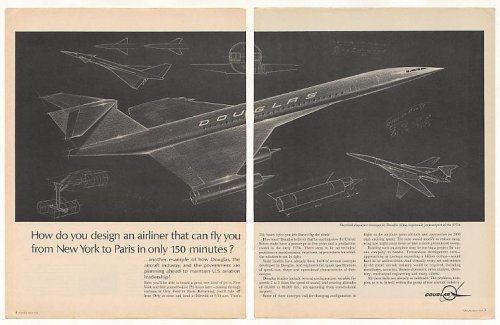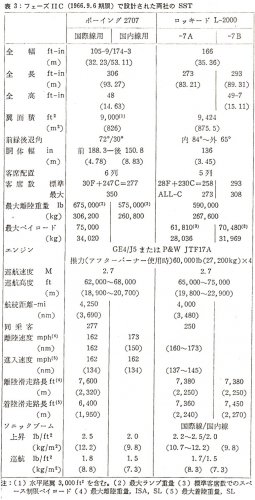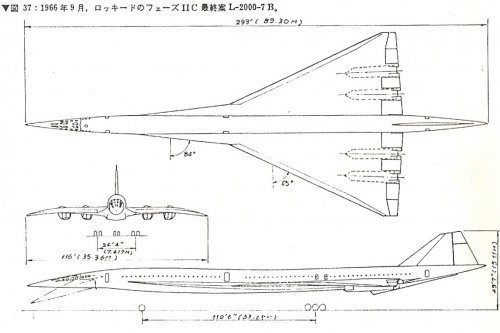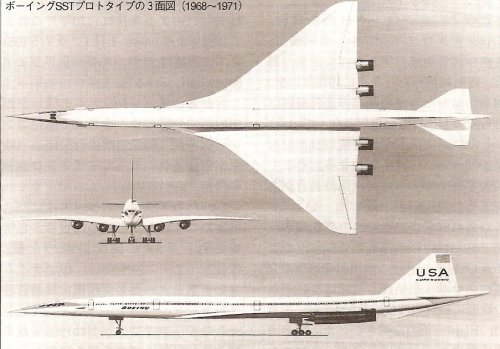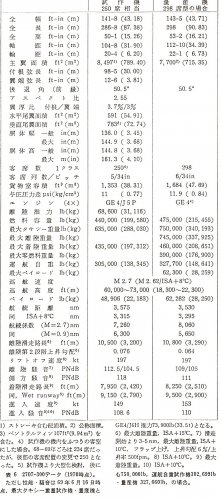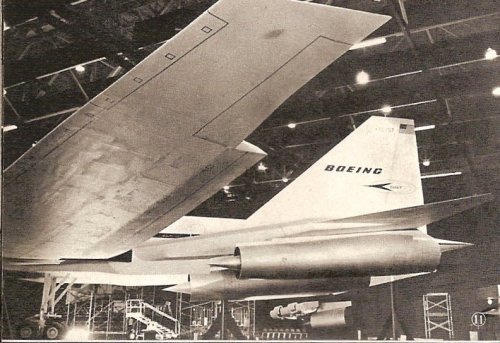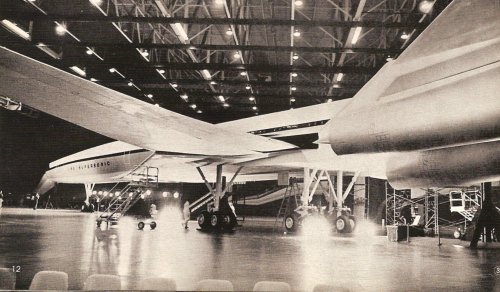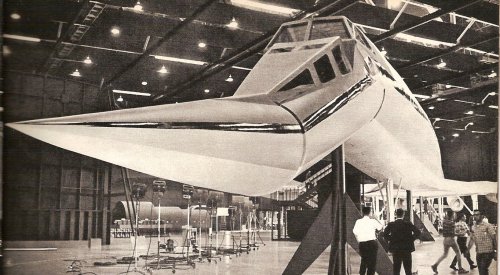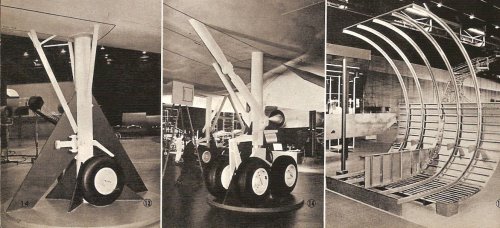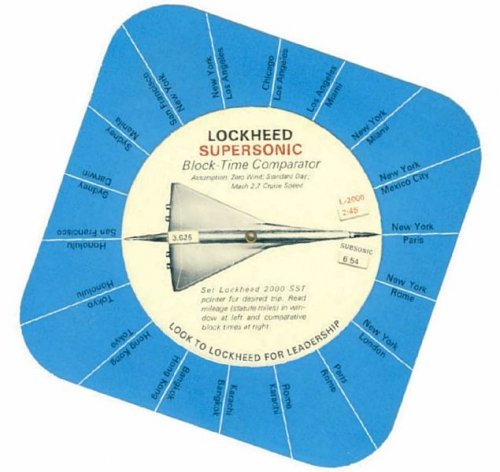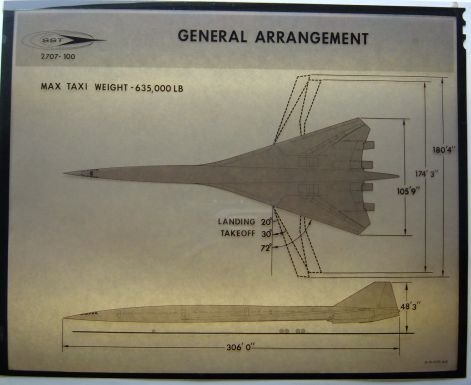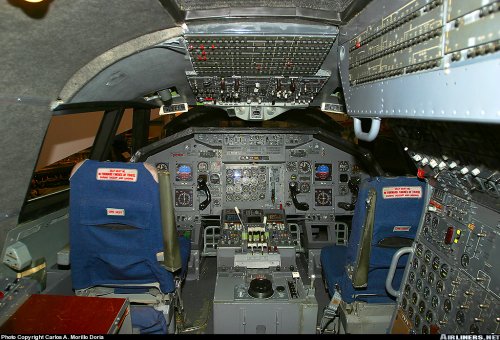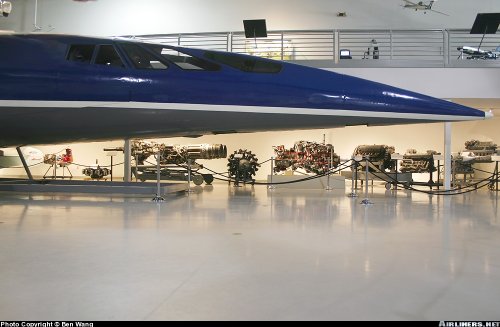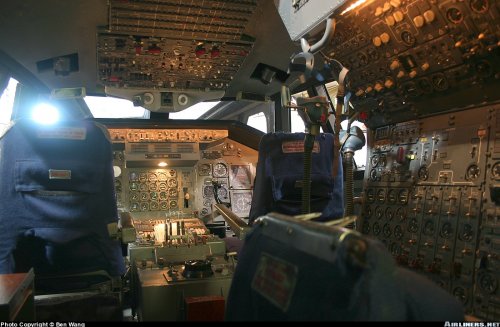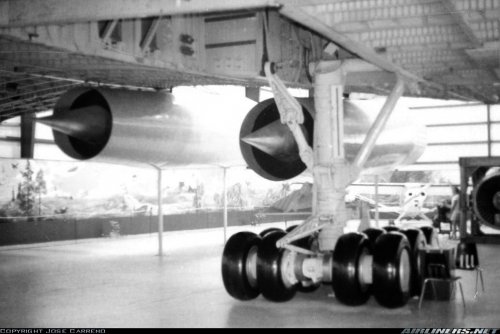You are using an out of date browser. It may not display this or other websites correctly.
You should upgrade or use an alternative browser.
You should upgrade or use an alternative browser.
US Supersonic Transport (SST) Program 1960-1971
- Thread starter Orionblamblam
- Start date
blackkite
Don't laugh, don't cry, don't even curse, but.....
- Joined
- 31 May 2007
- Messages
- 8,819
- Reaction score
- 7,692
PhaseⅡC(1996 September) specifications of Boeing 2707-200(international type and domestic type) and Lockheed L2000-7A/7B. It's written in Japanese language but I believe you can understand the meaning of datas.
Attachments
- Joined
- 27 May 2007
- Messages
- 676
- Reaction score
- 44
Great!
The Boeing 2707 has all kinds of front area rule bulging and takeoff rear fuselage banana curving going on. 24 main landing gear wheels! Separate horizontal tail and quite small wing. Spherical spike inlets. Lots of tiny windows, seems more than one per seat. Very long plane.
The Lockheed is more of a Concorde lookalike. Tailless delta. Although not as curvy (ogee) from above as concorde and four separage engine pods. The wing glove is very long, is this for very high AOA during landing or what?
The Boeing 2707 has all kinds of front area rule bulging and takeoff rear fuselage banana curving going on. 24 main landing gear wheels! Separate horizontal tail and quite small wing. Spherical spike inlets. Lots of tiny windows, seems more than one per seat. Very long plane.
The Lockheed is more of a Concorde lookalike. Tailless delta. Although not as curvy (ogee) from above as concorde and four separage engine pods. The wing glove is very long, is this for very high AOA during landing or what?
KJ_Lesnick
ACCESS: Top Secret
- Joined
- 13 February 2008
- Messages
- 1,042
- Reaction score
- 112
mz,
The reason for the strake is that due to it's high-sweep, relatively good incidence, and possibly it's contouring, it produces relatively high amounts of lift supersonically compared to the rest of the wing. The result is that even though the wing features an aft-shift in the center of pressure, the extra lift produced by the strake nullifies this out, allowing very low trim-drag and elevon deflections. It also produces a powerful vortex at low-speeds at high AoA's which then travels across the front of the rear-delta (which produces a vortex of it's own, boosting it)
Kendra Lesnick
The reason for the strake is that due to it's high-sweep, relatively good incidence, and possibly it's contouring, it produces relatively high amounts of lift supersonically compared to the rest of the wing. The result is that even though the wing features an aft-shift in the center of pressure, the extra lift produced by the strake nullifies this out, allowing very low trim-drag and elevon deflections. It also produces a powerful vortex at low-speeds at high AoA's which then travels across the front of the rear-delta (which produces a vortex of it's own, boosting it)
Kendra Lesnick
blackkite
Don't laugh, don't cry, don't even curse, but.....
- Joined
- 31 May 2007
- Messages
- 8,819
- Reaction score
- 7,692
flateric,KJ_lesnick and mz thank you very much for nice comments.
Yes L2000-7 has excellent aerodynamic characteristic, it's lift/drag ration(8.2-8.3) is higher than Boeing 2707-300's(7.34). But Boeing 2707-300 has good lift/drag ratio(14.2) in subsonic flight. It can operate economically in all flight envelope. Today I post the specification of Boeing 2707-300(prototype and mass-production type) and another drawing.
Yes L2000-7 has excellent aerodynamic characteristic, it's lift/drag ration(8.2-8.3) is higher than Boeing 2707-300's(7.34). But Boeing 2707-300 has good lift/drag ratio(14.2) in subsonic flight. It can operate economically in all flight envelope. Today I post the specification of Boeing 2707-300(prototype and mass-production type) and another drawing.
Attachments
- Joined
- 14 June 2006
- Messages
- 2,300
- Reaction score
- 557
Black, thanks for the postings ! And if you are from Japan, welcome here ! And if you are from somewhere else, welcome all the same ... ! 
BTW, if the L-2000-7 drawings are really from Phase IIC, they are not final. The "final" proposals for the two-side phase of the SST competition were Phase III. Lockheed finished earlier, by the end of September 1966, Boeing later in the year, and they managed to put together the Phase III proposal (BTW, largely available online on the DTIC database) just in time (and the design suffered from this). Unfortunately, Phase III Lockheed proposal isn't available online, we'll have to wait for someone digging up the FAA archives... none ever did this thoroughly (for example, there is the NAA Phase I proposal there.... and the Curtiss-Wright engine proposal... and the secret alternate configurations study commissioned to Boeing in 1966, looking an arrow wing designs....).
BTW, if the L-2000-7 drawings are really from Phase IIC, they are not final. The "final" proposals for the two-side phase of the SST competition were Phase III. Lockheed finished earlier, by the end of September 1966, Boeing later in the year, and they managed to put together the Phase III proposal (BTW, largely available online on the DTIC database) just in time (and the design suffered from this). Unfortunately, Phase III Lockheed proposal isn't available online, we'll have to wait for someone digging up the FAA archives... none ever did this thoroughly (for example, there is the NAA Phase I proposal there.... and the Curtiss-Wright engine proposal... and the secret alternate configurations study commissioned to Boeing in 1966, looking an arrow wing designs....).
blackkite
Don't laugh, don't cry, don't even curse, but.....
- Joined
- 31 May 2007
- Messages
- 8,819
- Reaction score
- 7,692
Thank you so much skybolt. I will check DTIC web page.I am very happy to get comments from the VIPs of this forum. I have kept great interest for U.S SST program especially L2000. But it's very difficult for me to get precise drawings. But I found best one in this forum which is Orionblamblam's post. But it's not final configulation. I think engine exhaust nozzle part is different from final configulation. I know many datas are included in Lockheed Hrizon magazine revision5 or No5 which I dont't have. I imagine most of L2000's detail datas are still top secret because no manufacture except Lockheed succeed to develop mach 3 cruiser.
I have one question that why Boeing or Lockheed did not apply compression lift theory which applied XB70 to it's SST design? Engine nacelles have the fanction for compresion lift?
I have one question that why Boeing or Lockheed did not apply compression lift theory which applied XB70 to it's SST design? Engine nacelles have the fanction for compresion lift?
- Joined
- 14 June 2006
- Messages
- 2,300
- Reaction score
- 557
Check your PMs..
Regarding compression lift, they didn't apply it simply because (I am oversemplificating, I must admit) there isn't anything like compression lift in the real world... The lift generated by the shockwave is compensated by additional drag. This was proved in the windtunnel at Langley since 1959, and later confirmed in flight testing of the XB-70. See NASA report TM-X-76 "An Experimental Pressure-Distribution Investigation of Interference Effects produced at a Mach number of 3.11 by Wedge-Shaped Bodies Located under a Triangular Wing"
Regarding compression lift, they didn't apply it simply because (I am oversemplificating, I must admit) there isn't anything like compression lift in the real world... The lift generated by the shockwave is compensated by additional drag. This was proved in the windtunnel at Langley since 1959, and later confirmed in flight testing of the XB-70. See NASA report TM-X-76 "An Experimental Pressure-Distribution Investigation of Interference Effects produced at a Mach number of 3.11 by Wedge-Shaped Bodies Located under a Triangular Wing"
Last edited by a moderator:
blackkite
Don't laugh, don't cry, don't even curse, but.....
- Joined
- 31 May 2007
- Messages
- 8,819
- Reaction score
- 7,692
Many thanks Skybolt. I immediately download the report. My long question will be disappear soon. Yes I am Japanese and crazy fan of Mr.Jozef Gatial.
He tought me this forum three years ago and from that time I check this forum every day. And found many valuable imformations. I want to contribute to this forum same as you.
He tought me this forum three years ago and from that time I check this forum every day. And found many valuable imformations. I want to contribute to this forum same as you.
KJ_Lesnick
ACCESS: Top Secret
- Joined
- 13 February 2008
- Messages
- 1,042
- Reaction score
- 112
The Phase III stuff is the mockup right?
KJ_Lesnick
ACCESS: Top Secret
- Joined
- 13 February 2008
- Messages
- 1,042
- Reaction score
- 112
blackkite
Don't laugh, don't cry, don't even curse, but.....
- Joined
- 31 May 2007
- Messages
- 8,819
- Reaction score
- 7,692
KJ_Lesnic and Skybolt, let me participate this very interesting discussion.
My conjectures are as follows.
1.Mockup was made based on early PHASEⅡ design.
2.In PHASEⅢ design, engine nacelles were little lowered to aviod interaction between wing trailing edge, engine nozzles were extended toward aft direction to decrease drag and partial cut of wing trailing edge was avoided.
3.Mockup's nose was little long compared with PHASEⅢ desige.
My conjectures are as follows.
1.Mockup was made based on early PHASEⅡ design.
2.In PHASEⅢ design, engine nacelles were little lowered to aviod interaction between wing trailing edge, engine nozzles were extended toward aft direction to decrease drag and partial cut of wing trailing edge was avoided.
3.Mockup's nose was little long compared with PHASEⅢ desige.
- Joined
- 14 June 2006
- Messages
- 2,300
- Reaction score
- 557
Mock-ups didn't capture the real configurations that were proposed by both competitors at Phase III, and even late Phase IIC. For example, in Boeing's design, the position of the engine nacelles weren't fixed even in Phase III proposal, and the mock-up reflected (or didn't) it. In general, single elements of both designs changed so rapidly that, considering the length of the mock-up building process, it would have been impossible to keep it up-to-date. Even the 2707-300 half-mock-up as built was surpassed by the very late modifications being proposed during 1970. So, for sake of precision, every drawings or artistic impression of SST proposal have to sport a "as at XX XXX 19XX". Otherwise, be content to give a very general impression of what was going on. I myself have not (and don't know someone who really has) documentation of all the drawing evolutions that were produced, for example in the mid-term of Phases documents, only a couple of which are available. If you know the literature of the time, you'll notice how frustrated and puzzled were the writers seeing the designs evolve in seemingly un-convergent ways (the tail position of the Boeing VG design is just a macroscopic example). In short, and this is an invitation to search, historical knowledge on the SST program is far from stabilized: we think to know relatively well the general evolution, but the single phases whys and whats are still much to be researched. Just to give you in example, only in 2002 someone dig up from the FAA archive the official end of Phase III decision explanation document, and didn't published it, only cited.
blackkite
Don't laugh, don't cry, don't even curse, but.....
- Joined
- 31 May 2007
- Messages
- 8,819
- Reaction score
- 7,692
- Joined
- 1 April 2006
- Messages
- 11,375
- Reaction score
- 10,202
- Joined
- 1 April 2006
- Messages
- 11,375
- Reaction score
- 10,202
blackkite
Don't laugh, don't cry, don't even curse, but.....
- Joined
- 31 May 2007
- Messages
- 8,819
- Reaction score
- 7,692
Thank you Flateric for many historical valuables. I feel B2707-300's mock-up pictures are very few because some details are still top secret. B2707-300's cockpit was very narrow and visibility was very limited like high speed racing car. This clearly shows Boeing's big effort to reduce drag.
KJ_Lesnick
ACCESS: Top Secret
- Joined
- 13 February 2008
- Messages
- 1,042
- Reaction score
- 112
Some of the B-2707 is still top secret?
Kendra
Kendra
blackkite
Don't laugh, don't cry, don't even curse, but.....
- Joined
- 31 May 2007
- Messages
- 8,819
- Reaction score
- 7,692
KJ_Lesnick. This is only my feeling by the fact that I saw only few mock-up pictures of Boeing B2707-300.I think Boeing B2707-300's mock-up was very detailed one which based on manufacturing drawings. I can't point out the secret region exactly. But I think some secret exist in controlled smoothness dimple pattern for wing surface to protect thermal expansion buckling which applied to SR-71 and L2000 not applied to XB-70. I have searched the book which focused on American first generation SST, but I can't find the book till today. It is very strange for me. I feel first generation SST story is untouchable for American aerospace historian. Very famous Mr.Jay Miller or Mr.Scott Lowther did not treate this theme. Sorry I can't answer your question directly. (I have a question that why Sukhoi T-4 did not attack mach 3 speed. Perhaps Sukhoi design team did not know the key point for mach 3 cruising in that day.Is it thermal problem or stability problem?)
KJ_Lesnick
ACCESS: Top Secret
- Joined
- 13 February 2008
- Messages
- 1,042
- Reaction score
- 112
Blackkite,
I doubt the corrugation is a secret. There are pictures on the top of the L-2000's wing (the mockup, it has a picture of some flight attendants who are dressed up in what looks like some wacky uniform) which show extensive corrugation, it's also documented in some articles of the L-2000. There's also various stuff which states that the A-12 has corrugations in it's wings in order to deal with thermal expansion.
Controlled-smoothness dimpling might be used as a form of boundary layer control though... recently at least I remember hearing at least one of the Quiet Supersonic (Business Jet) designs which used a dimpling pattern to improve airflow over the fronts of the wings (supposedly it was the same principle why golf-balls fly so well)
To the best of my knowledge, if it's publicly mentioned, it's probably not classified. If it is classified though, let's hope neither or both of us get heart-attacks ;D
Kendra Lesnick
I doubt the corrugation is a secret. There are pictures on the top of the L-2000's wing (the mockup, it has a picture of some flight attendants who are dressed up in what looks like some wacky uniform) which show extensive corrugation, it's also documented in some articles of the L-2000. There's also various stuff which states that the A-12 has corrugations in it's wings in order to deal with thermal expansion.
Controlled-smoothness dimpling might be used as a form of boundary layer control though... recently at least I remember hearing at least one of the Quiet Supersonic (Business Jet) designs which used a dimpling pattern to improve airflow over the fronts of the wings (supposedly it was the same principle why golf-balls fly so well)
To the best of my knowledge, if it's publicly mentioned, it's probably not classified. If it is classified though, let's hope neither or both of us get heart-attacks ;D
Kendra Lesnick
- Joined
- 1 April 2006
- Messages
- 11,375
- Reaction score
- 10,202
Uploaded some US SST chronicles (full-scale mock-ups/engine tests/aerodynamic issues) from The Wings Over The World to YouTube, plus found beautiful 2707-200/L-2000 full-scale mock-ups footage from Bomberguy. This one is really exciting.
KJ_Lesnick
ACCESS: Top Secret
- Joined
- 13 February 2008
- Messages
- 1,042
- Reaction score
- 112
flateric,
Great videos!!! Lots of stuff I haven't even seen before (The Phase I mock-up for example), and I like video 3 and 4 which visually explain the L-2000's wing and inlet aerodynamics in easy to understand terms.
BTW: I have a question or two though...
Regarding Video II
-I thought the B-2707-100 was the swing-wing version depicted, no? To the best of my knowledge the -200 was the one with the canard and the stretched fuselage...
-Are the maximum altitude figures correct? I'm just curious since they're listed as identical on both versions (and while this is possible, I've often heard different figures for each), and to the I have heard some figures on google which list a max altitude of 77,000 or 78,000 feet with the typical altitude at the end of the cruise portion being around 76,500 (with initial level-of figures being approximately 71,500)
Regarding Video IV
-While one of the engines (which to the best of my knowledge is the GE-4 as I've seen pictures of that engine run before) produced a normal diamond-shock pattern, one of the engines (which I'm almost certain is JTF-17A judging by the engine's shape) though during the test run depicted produced a rather weird exhaust-pattern (didn't look like the typical diamond-shock pattern, it just looked red with a whole bunch of shock-lines in it), what caused that to happen?
Kendra Lesnick
Great videos!!! Lots of stuff I haven't even seen before (The Phase I mock-up for example), and I like video 3 and 4 which visually explain the L-2000's wing and inlet aerodynamics in easy to understand terms.
BTW: I have a question or two though...
Regarding Video II
-I thought the B-2707-100 was the swing-wing version depicted, no? To the best of my knowledge the -200 was the one with the canard and the stretched fuselage...
-Are the maximum altitude figures correct? I'm just curious since they're listed as identical on both versions (and while this is possible, I've often heard different figures for each), and to the I have heard some figures on google which list a max altitude of 77,000 or 78,000 feet with the typical altitude at the end of the cruise portion being around 76,500 (with initial level-of figures being approximately 71,500)
Regarding Video IV
-While one of the engines (which to the best of my knowledge is the GE-4 as I've seen pictures of that engine run before) produced a normal diamond-shock pattern, one of the engines (which I'm almost certain is JTF-17A judging by the engine's shape) though during the test run depicted produced a rather weird exhaust-pattern (didn't look like the typical diamond-shock pattern, it just looked red with a whole bunch of shock-lines in it), what caused that to happen?
Kendra Lesnick
- Joined
- 14 June 2006
- Messages
- 2,300
- Reaction score
- 557
There were two Dash 200, one w/o canards and one later with them. This was the last effort to save the VG config, then they went back to the drawing board (and computers, and tunnel, and ...). See document I posted in Useful Links section.
KJ_Lesnick
ACCESS: Top Secret
- Joined
- 13 February 2008
- Messages
- 1,042
- Reaction score
- 112
Skybolt said:Actually the Curtiss-Wright was the most advanced of all three engine proposals, but it was deemed not available in time for the original assumed schedule of the SST (first flight in 1971). There was a lot of controversy, with NASA and Air Force insisting in keeping Curtiss-Wright in the game with funds for building a second-generation supersonic transport engine for the 1975 time-frame. But the FAA was racing with Concorde, so Curtiss-Wright was dropped. BTW, the company put significant resources in the design of that engine, but to no avail. The Air Force had already shifted to highly-subsonic low level penetration with incoming and outcoming supersonic legs for their post-XB-70 bombers concepts.
What particular qualities made the Curtiss-Wright engine the most advanced?
KJ_Lesnick
ACCESS: Top Secret
- Joined
- 13 February 2008
- Messages
- 1,042
- Reaction score
- 112
Skybolt said:There were two Dash 200, one w/o canards and one later with them. This was the last effort to save the VG config, then they went back to the drawing board (and computers, and tunnel, and ...). See document I posted in Useful Links section.
I checked the Useful Links section, all four pages. I couldn't find anything on the 2707-200...
Kendra Lesnick
- Joined
- 14 June 2006
- Messages
- 2,300
- Reaction score
- 557
blackkite
Don't laugh, don't cry, don't even curse, but.....
- Joined
- 31 May 2007
- Messages
- 8,819
- Reaction score
- 7,692
Flateric,Skybolt Super! How many treasures you have! Till today I don't know the existence of phase ⅠL2000's full size mock-up. I surprised very much that L2000's mock-up undercarriage retracted to the fuselage. B2707-300's mock-up is very beautiful. It was very magnificient air plane. The warp of the wing of Boeing B2707 and L2000 to reduce drug is clearly visible. Long time ago, I heard that P&W JTF17A had thermal problem. Normally turbo fan engine is surrounded by rather low temperature fan flow but JTF17A had duct burner and engine is surrouned by high temperature combustion gas and engine temperature became high.
Attachments
Similar threads
-
FLIGHTS OF FANTASY: The Lockheed L-2000 SST in airline service
- Started by Sentinel Chicken
- Replies: 9
-
Could the US have built an SST?
- Started by uk 75
- Replies: 35
-
-
-

